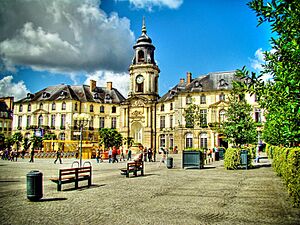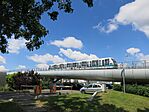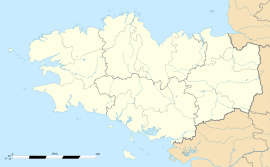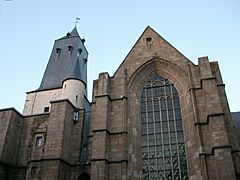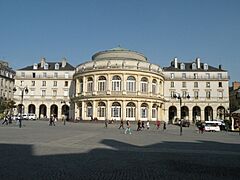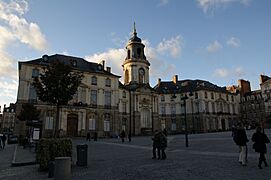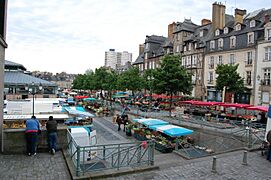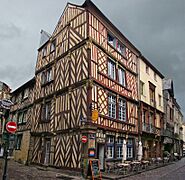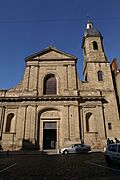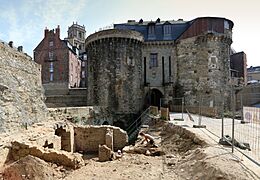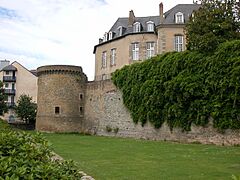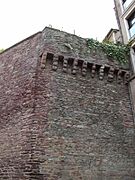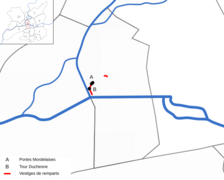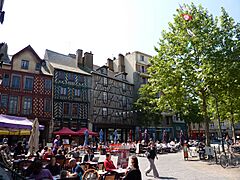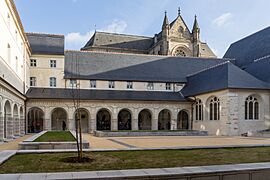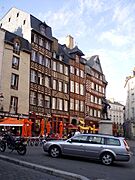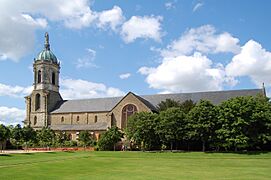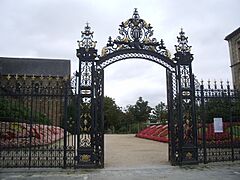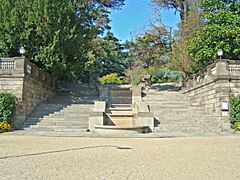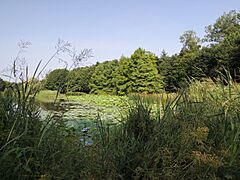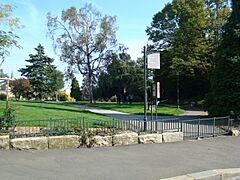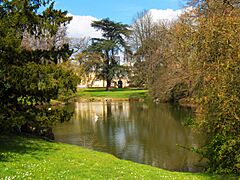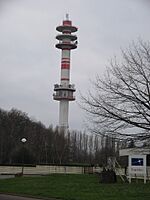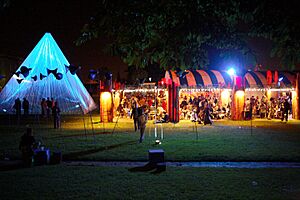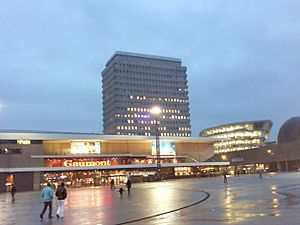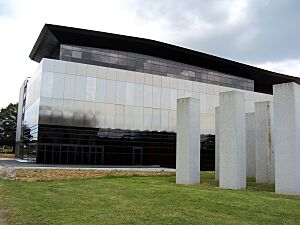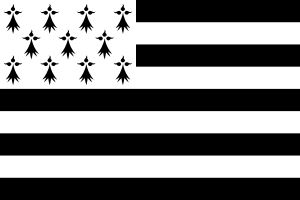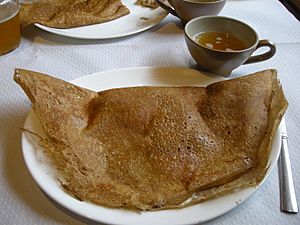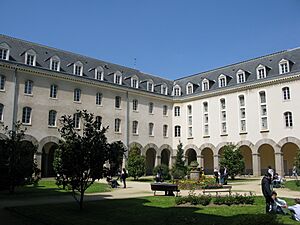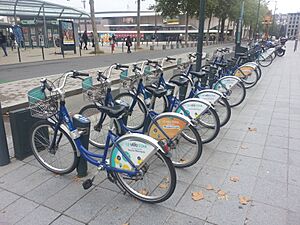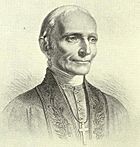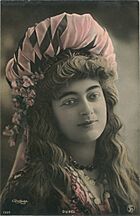Rennes facts for kids
Quick facts for kids
Rennes
|
|||
|---|---|---|---|
|
Prefecture and commune
|
|||
|
Top to bottom, left to right: Place de la Mairie; Marché des Lices; Rennes Metro; Esplanade Charles de Gaulle; Opera of Rennes by night; University of Rennes 2; and skyline of Rennes from Cathedral
|
|||
|
|||
| Motto(s): | |||
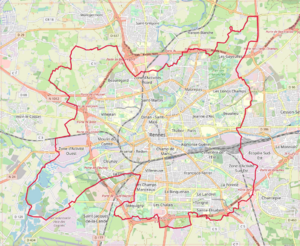 |
|||
| Country | France | ||
| Region | Brittany | ||
| Department | Ille-et-Vilaine | ||
| Arrondissement | Rennes | ||
| Canton | Rennes-1, 2, 3, 4, 5 and 6 | ||
| Intercommunality | Rennes Métropole | ||
| Area
1
|
50.39 km2 (19.46 sq mi) | ||
| • Urban | 327.7 km2 (126.5 sq mi) | ||
| • Metro | 3,804.3 km2 (1,468.8 sq mi) | ||
| Population
(2021)
|
225,081 | ||
| • Density | 4,466.8/km2 (11,568.9/sq mi) | ||
| • Urban
(2018)
|
359,934 | ||
| • Urban density | 1,098.36/km2 (2,844.8/sq mi) | ||
| • Metro
(2018)
|
747,156 | ||
| • Metro density | 196.3978/km2 (508.668/sq mi) | ||
| Demonym(s) | Rennais(e) | ||
| Time zone | UTC+01:00 (CET) | ||
| • Summer (DST) | UTC+02:00 (CEST) | ||
| INSEE/Postal code |
35238 /35000, 35200, 35700
|
||
| Elevation | 20–74 m (66–243 ft) (avg. 30 m or 98 ft) |
||
| 1 French Land Register data, which excludes lakes, ponds, glaciers > 1 km2 (0.386 sq mi or 247 acres) and river estuaries. | |||
Rennes (French pronunciation: [ʁɛn]; Breton: Roazhon [ˈrwɑːõn]; Gallo: Resnn) is a cool city in northwestern France. It is located in the east of Brittany, where the Ille and Vilaine rivers meet. Rennes is the main city of the Brittany region. It is also the capital of the Ille-et-Vilaine department.
In 2017, about 357,327 people lived in the city area. The larger metropolitan area had 739,974 people. People from Rennes are called Rennais (boys/men) or Rennaises (girls/women) in French.
Rennes has a long history, going back over 2,000 years. It started as a small Gallic village called Condate. It was one of the most important cities in the old Duchy of Brittany. From the 1500s until the French Revolution, Rennes was a key city for law and government in Brittany. Its 17th-century Parliament's Palace shows this history.
A big fire in 1720 destroyed much of the old wooden city center. It was then rebuilt using stone. After World War II, Rennes grew a lot. Many people moved from the countryside to the city. It became important for making cars and for new technology.
Since the 1980s, Rennes has been a leader in telecommunications and high-tech. It is now a major digital innovation center in France. In 2002, Rennes became the smallest city in the world to have a Metro train line.
Rennes is known as a city of art and history. It has many old buildings, with over 90 protected as historic monuments. It is also a big university city, with over 66,000 students in 2016. In 2018, the magazine L'Express called Rennes "the most liveable city in France."
Contents
How Rennes is Governed
Rennes is split into different areas called cantons and quarters.
Cantons of Rennes
Since 2015, Rennes has 6 cantons. Here are their populations from 2019:
- Canton of Rennes-1 (40,588 people)
- Canton of Rennes-2 (42,446 people)
- Canton of Rennes-3 (43,683 people), which includes parts of Rennes and the town of Chantepie
- Canton of Rennes-4 (36,348 people)
- Canton of Rennes-5 (46,759 people), which includes parts of Rennes and the town of Saint-Jacques-de-la-Lande
- Canton of Rennes-6 (46,750 people), which includes parts of Rennes and the town of Pacé
Quarters of Rennes
Rennes is also divided into 12 quarters:
- Centre
- Thabor - Saint-Hélier - Alphonse Guérin
- Bourg L’Évesque - La Touche - Moulin du Comte
- Saint-Martin
- Maurepas - Bellangerais
- Jeanne d’Arc - Longs Champs - Atlante Beaulieu
- Francisco Ferrer - Landry - Poterie
- Sud Gare
- Cleunay - Arsenal - Redon - La Courrouze
- Villejean - Beauregard
- Le Blosne
- Bréquigny
Mayors of Rennes
The current mayor of Rennes is Nathalie Appéré. She is a member of the Socialist Party. She became mayor in 2014.
Some famous past mayors include:
- Edmond Hervé (1977 to 2008)
- Henri Fréville (1953 to 1977)
- Jean Janvier (1908 to 1923)
The city hall (called mairie) is right in the center of Rennes.
Geography and Climate
Rennes is built on a hill, with the northern part being higher. It is located where the Ille and Vilaine rivers meet.
Rennes is about 50 kilometers (31 miles) from the English Channel. This is near cities like Saint-Malo and Dinard.
The city has a special "Green Belt" around its main road. This is a protected area between the busy city and the more rural areas around it.
Weather in Rennes
Rennes has an oceanic climate, which means it has mild weather. It gets less rain than western parts of Brittany. The amount of sunshine is similar to cities like Lausanne.
| Climate data for Rennes (RNS), elevation: 36 m (118 ft), 1991–2020 normals, extremes 1945–present | |||||||||||||
|---|---|---|---|---|---|---|---|---|---|---|---|---|---|
| Month | Jan | Feb | Mar | Apr | May | Jun | Jul | Aug | Sep | Oct | Nov | Dec | Year |
| Record high °C (°F) | 16.8 (62.2) |
20.9 (69.6) |
24.1 (75.4) |
28.7 (83.7) |
30.8 (87.4) |
37.9 (100.2) |
40.5 (104.9) |
39.5 (103.1) |
34.8 (94.6) |
30.0 (86.0) |
21.4 (70.5) |
17.8 (64.0) |
40.5 (104.9) |
| Mean daily maximum °C (°F) | 9.2 (48.6) |
10.2 (50.4) |
13.2 (55.8) |
16.0 (60.8) |
19.3 (66.7) |
22.6 (72.7) |
24.8 (76.6) |
24.7 (76.5) |
21.9 (71.4) |
17.2 (63.0) |
12.5 (54.5) |
9.6 (49.3) |
16.8 (62.2) |
| Daily mean °C (°F) | 6.2 (43.2) |
6.6 (43.9) |
8.8 (47.8) |
11.0 (51.8) |
14.3 (57.7) |
17.3 (63.1) |
19.2 (66.6) |
19.3 (66.7) |
16.6 (61.9) |
13.2 (55.8) |
9.2 (48.6) |
6.6 (43.9) |
12.4 (54.3) |
| Mean daily minimum °C (°F) | 3.3 (37.9) |
2.9 (37.2) |
4.5 (40.1) |
6.0 (42.8) |
9.3 (48.7) |
12.1 (53.8) |
13.7 (56.7) |
13.8 (56.8) |
11.4 (52.5) |
9.3 (48.7) |
5.9 (42.6) |
3.6 (38.5) |
8.0 (46.4) |
| Record low °C (°F) | −14.7 (5.5) |
−11.2 (11.8) |
−7.3 (18.9) |
−3.2 (26.2) |
−1.2 (29.8) |
2.2 (36.0) |
5.5 (41.9) |
4.0 (39.2) |
1.9 (35.4) |
−4.6 (23.7) |
−7.5 (18.5) |
−12.6 (9.3) |
−14.7 (5.5) |
| Average precipitation mm (inches) | 66.6 (2.62) |
51.6 (2.03) |
48.9 (1.93) |
51.2 (2.02) |
58.1 (2.29) |
50.9 (2.00) |
44.0 (1.73) |
43.5 (1.71) |
56.6 (2.23) |
73.1 (2.88) |
73.2 (2.88) |
73.3 (2.89) |
691.0 (27.20) |
| Average precipitation days (≥ 1.0 mm) | 11.5 | 10.1 | 8.9 | 9.9 | 8.9 | 7.4 | 7.1 | 7.1 | 7.8 | 11.0 | 12.5 | 12.3 | 114.6 |
| Average snowy days | 1.9 | 2.9 | 1.0 | 0.4 | 0.0 | 0.0 | 0.0 | 0.0 | 0.0 | 0.0 | 0.2 | 1.3 | 7.7 |
| Average relative humidity (%) | 87 | 83 | 79 | 76 | 77 | 75 | 75 | 76 | 80 | 85 | 87 | 87 | 81 |
| Mean monthly sunshine hours | 68.3 | 92.7 | 134.1 | 173.8 | 202.1 | 213.3 | 220.2 | 207.2 | 180.7 | 116.7 | 83.5 | 69.0 | 1,761.5 |
| Source 1: Meteo France (snow days 1981–2010) | |||||||||||||
| Source 2: Infoclimat.fr (relative humidity 1961–1990) | |||||||||||||
Population Growth in Rennes
In 2018, the city of Rennes had 221,272 people living in it. The larger area around Rennes, called Rennes Métropole, had 450,593 people. The total metropolitan area was home to almost 750,000 people.
Rennes is one of the fastest-growing metropolitan areas in France. It is second only to Toulouse in how quickly its population is increasing.
| Historical population | |||||||||||||||||||||||||||||||||||||||||||||||||||||||||||||||||||||||||||||||||||||||||||||||||||||||||||||||||||||||||||||
|---|---|---|---|---|---|---|---|---|---|---|---|---|---|---|---|---|---|---|---|---|---|---|---|---|---|---|---|---|---|---|---|---|---|---|---|---|---|---|---|---|---|---|---|---|---|---|---|---|---|---|---|---|---|---|---|---|---|---|---|---|---|---|---|---|---|---|---|---|---|---|---|---|---|---|---|---|---|---|---|---|---|---|---|---|---|---|---|---|---|---|---|---|---|---|---|---|---|---|---|---|---|---|---|---|---|---|---|---|---|---|---|---|---|---|---|---|---|---|---|---|---|---|---|---|---|
|
|
|
|||||||||||||||||||||||||||||||||||||||||||||||||||||||||||||||||||||||||||||||||||||||||||||||||||||||||||||||||||||||||||
| Source: EHESS and INSEE | |||||||||||||||||||||||||||||||||||||||||||||||||||||||||||||||||||||||||||||||||||||||||||||||||||||||||||||||||||||||||||||
What to See in Rennes
Rennes is known as a city of art and history. It has many interesting places to visit.
Historic City Center
The old part of Rennes is built where the city walls used to be. The northern and southern parts of the city center look different. This is because a big fire in 1720 destroyed most of the wooden houses in the north. This area was rebuilt with stone buildings in a grid pattern. The southern part, which was poorer, was not rebuilt in the same way.
Many grand homes, called "hôtels particuliers", were built in the richer northern part during the 18th century. Most of the city's historic buildings can be found here.
You can see colorful traditional half-timbered houses on streets like Saint-Sauveur and around squares like Champ-Jacquet.
Parliament and City Hall Area
The Parlement de Bretagne (Brittany Parliament) is a famous 17th-century building in Rennes. It was rebuilt after a fire in 1994. Today, it is home to the Rennes Court of Appeal. The square around it is built in a classical style.
Near the city hall square (Place de la Mairie), you'll find:
- The City Hall
- The Opera House
To the east, at the end of Rue Saint-Georges, you can see traditional half-timbered houses and:
- The 1920s Saint George Municipal Pool, with cool mosaics.
- Saint George Palace, and its beautiful garden.
Place des Lices and Cathedral Area
The Place des Lices is a large square with many grand homes. It is also where a big weekly market, the Marché des Lices, takes place.
Near the Rennes Cathedral (cathédrale Saint-Pierre de Rennes) is Rue du Chapitre. Here you can see:
- Hôtel de Blossac
- Old wooden busts from the 16th century on the front of a building at 20, Rue du Chapitre.
Also in this area are the old St. Yves chapel, which is now the tourist office, and the Basilica Saint-Sauveur.
Old City Walls
Parts of the old city walls, built between the 3rd and 12th centuries, can still be seen. Most of them were taken down between the 1500s and 1860s.
Place Saint-Anne Area
The Place Saint-Anne (Plasenn Santez-Anna) is another important square. Here you'll find:
- Saint-Aubin Church, built in the early 1900s.
- The site of a former 14th-century hospital.
- The Jacobite convent, which is now a convention center.
To the southwest, Rue Saint-Michel is famous for its many bars. To the southeast, Place du Champ-Jacquet has Renaissance buildings and a statue of Mayor Jean Leperdit.
Thabor Park Area
This area includes the Saint-Melaine square.
The Notre-Dame-en-Saint-Melaine basilica has parts from the 11th century. It also has 14th-century Gothic arches and a 17th-century colonnade. Its bell tower has a gilded Virgin Mary statue from the 19th century.
The Jardin botanique du Thabor is a beautiful botanical garden covering 10 hectares (about 25 acres). It was built between 1860 and 1867.
South of the Vilaine River
The Fine Arts Museum is located by the Vilaine River.
Les Champs Libres is a modern building designed by Christian de Portzamparc. It houses the Brittany Museum (Musée de Bretagne), a large library, and the Espace des Sciences science center with a planetarium.
At Place Honoré Commeurec, you'll find Les Halles Centrales. This was a covered market from 1922, and part of it is now an art gallery.
Parks and Gardens
Rennes has several lovely parks and gardens for people to enjoy.
Parc du Thabor has a significant botanical garden, the Jardin botanique du Thabor. The University of Rennes 1 also has a botanical garden on its campus.
Rennes' Economy
Rennes' economy is strong in several areas. These include car manufacturing, telecommunications, digital technology, and food production.
Orange (a telecommunications company) is the largest private employer in Rennes. It has 4,800 workers. PSA Peugeot Citroën is the second largest, with 3,000 employees.
Rennes has the second-highest number of digital and ICT (Information and Communication Technology) companies in France, after Paris. Many well-known companies like Google, Thales, and Ubisoft have offices here. Rennes was one of the first French cities to get the "French Tech" label in 2014.
The city also has a strong focus on research in digital and ICT. About 3,000 people work in 10 different research labs. Rennes is also a leader in the French food industry. Many food companies are located here, and there's a big international food expo called SPACE every September.
Other large companies in Rennes include Groupe Le Duff (which owns restaurant chains like Brioche Dorée) and Ouest-France, one of the most-read French newspapers.
Culture and Fun in Rennes
Rennes is known as one of the most lively cities in France. It invests a lot in arts and culture. Many of its festivals are famous across the country. These include the music festival Les Transmusicales, Les Tombées de la Nuit, and Travelling (a film festival). In the 1980s, Rennes was a big center for rock and new wave music in France.
Les Champs Libres is the biggest cultural place in Brittany. Over a million people visit it each year. It has a library with 120,000 documents. It also has the Museum of Brittany, a science space, and a planetarium.
Music and Performance Venues
Rennes has many places for music and shows:
- The MusikHall: For very large concerts (7,000 seats).
- Le Liberté: For major cultural events (5,300 seats).
- La Cité: For modern music and local artists (1,150 seats).
- Rennes Opera House: For opera and orchestra performances (650 seats).
Museums and Art Spaces
There are five museums in Rennes:
- Musée des Beaux Arts (Museum of Fine Arts of Rennes): An art museum with many sculptures.
- Musée de Bretagne Museum of Brittany: Located at Les Champs Libres.
- Museum of Farming and Rennes Countryside: South of Rennes.
- Musée des Transmissions (Museum of Broadcasting): East of Rennes.
- FRAC Bretagne (Regional Fund for Contemporary Art).
There are also art galleries like 40mcube and La Criée.
Local Media
Rennes was one of the first French cities to have its own local TV channel, 'TV Rennes', started in 1987.
The city also has local radio stations and newspapers. These include Ouest-France, which is one of the most-read French newspapers in the world.
Local Culture and Food
In Brittany, two regional languages are spoken: Breton and Gallo. In Rennes, Gallo was the main local language. However, Breton has also been spoken by people who moved from western Brittany.
Today, the Breton language is taught in some schools and universities.
Delicious Local Food
Some special foods from Rennes include:
- Breton galette: A savory pancake.
- Galette-saucisse: A sausage wrapped in a galette.
- Crêpe: A thin pancake, often sweet.
- Cider: An alcoholic drink made from apples.
You can find many other Breton foods at the Marché des Lices. This is a big weekly market held every Saturday morning.
Education in Rennes
Rennes is a big student city, with about 63,000 students.
The city has two main universities:
- Université de Rennes 1: Offers courses in science, technology, medicine, law, and economics.
- Université Rennes 2: Focuses on arts, literature, languages, and social sciences. It is the largest university for these subjects in western France.
There are also several specialized schools, called École Supérieures. These include the École Normale Supérieure de Rennes and the ESC Rennes School of Business.
Other important schools include branches of École Supérieure d'Électricité (Supélec) and Institut National des Sciences Appliquées.
The Catholic University of Rennes was founded in 1989.
Rennes also hosts an American study abroad program for high school students. This program helps students learn French culture and language.
Sports in Rennes
Football
- Rennes is home to Stade Rennais F.C., a football club that plays in Ligue 1. Their home stadium is the Roazhon Park.
Handball
- Cesson-Sévigné (near Rennes) has a handball team, Cesson-Rennes-Métropole. They play in the top division.
Cycling
- Rennes is home to Fortuneo-Vital Concept, a professional cycling team.
Rugby
- Rennes has a women's rugby team, Stade Rennais Rugby. They play in the top national league.
- The men's team, REC Rugby, plays in a lower national league.
Getting Around Rennes
Rennes has good ways to travel by road, train, and air.
Public Transport
The city has a large bus network with 65 lines. It also has a light metro train line. The first metro line opened in 2002. It is 9.4 kilometers (5.8 miles) long and has 15 stations. A second metro line, Line B, opened in September 2022.
Cycling in the City
Rennes has a bike-sharing system called STAR, le vélo. It has 900 bicycles available for use. Rennes was the first French city to create a modern bike-sharing system in 1998.
Roads and Highways
Rennes is a key point in Brittany's road network. It is surrounded by a ring road called the Rocade. This road is 31 kilometers (18.5 miles) long and has no tolls. You can reach nearby cities like Saint-Malo in 45 minutes and Nantes in 1 hour.
Train Travel
Rennes has a major train station, the Gare de Rennes, which opened in 1857. Since 2017, you can reach Paris by high-speed train (TGV) in just one hour and twenty-seven minutes. Trains also connect Rennes to other big French cities like Lyon and Marseille.
The TER Bretagne regional trains connect Rennes to many other towns in Brittany.
Flying from Rennes
Rennes is served by Rennes Brittany Airport. It is about 7 kilometers (4.3 miles) southwest of the city center. The airport has regular flights to major cities in France and other European countries like London, Amsterdam, and Barcelona.
Famous People from Rennes

Many notable people were born in or lived in Rennes:
- Soazig Aaron (born 1949), a writer.
- Georges Ernest Boulanger (1837–1891), a general and politician.
- Simon William Gabriel Bruté de Rémur (1779–1839), a French missionary in the US.
- Yvonne Dubel (1881–1958), a soprano opera singer.
- Félix Dujardin (1801–1860), a professor and famous parasitologist.
- Malika Ménard (born 1987), Miss France 2010.
- François-Henri Pinault (born 1962), a successful businessman.
- René Pleven (1901–1993), who was twice the Prime Minister of France.
- Valentina Tronel (born 2009), a singer who won the Junior Eurovision Song Contest 2020.
- Charles Vanel (1892–1989), a well-known actor.
Rennes Around the World
Rennes has special connections with many cities around the world. These are called twin towns or sister cities.
Twin Towns and Sister Cities
Rennes is twinned with:
 Exeter, England, UK (since 1956)
Exeter, England, UK (since 1956) Rochester, New York, US (since 1958)
Rochester, New York, US (since 1958) Erlangen, Germany (since 1964)
Erlangen, Germany (since 1964) Brno, Czech Republic (since 1965)
Brno, Czech Republic (since 1965) Sendai, Japan (since 1967)
Sendai, Japan (since 1967) Leuven, Belgium (since 1980)
Leuven, Belgium (since 1980) Sétif, Algeria (since 1982)
Sétif, Algeria (since 1982) Cork, Ireland (since 1982)
Cork, Ireland (since 1982) Almaty, Kazakhstan (since 1991)
Almaty, Kazakhstan (since 1991) Bandiagara Cercle, Mali (since 1995)
Bandiagara Cercle, Mali (since 1995) Poznań, Poland (since 1998)
Poznań, Poland (since 1998) Sibiu, Romania (since 1999)
Sibiu, Romania (since 1999) Jinan, China (since 2002)
Jinan, China (since 2002) Santiago de Compostela, Spain (since 2010)
Santiago de Compostela, Spain (since 2010)
Other Partnerships
Rennes also has friendly ties with some towns in France:
 Saint-Gilles-du-Mené, France (since 1978)
Saint-Gilles-du-Mené, France (since 1978) Rennes-les-Bains, France (since 1985)
Rennes-les-Bains, France (since 1985)
It also has cooperation agreements, like with Huế, Vietnam.
Images for kids
See also
 In Spanish: Rennes para niños
In Spanish: Rennes para niños


